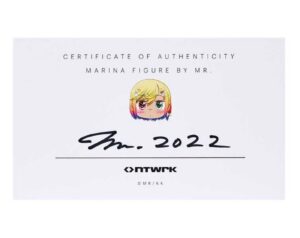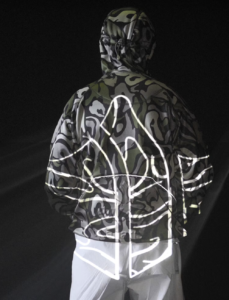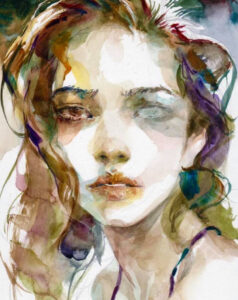
“Marina – A Purple Morning” (2022) is a vibrant, vinyl-based artwork by Mr., one of Japan’s most controversial and provocative neo-pop artists working under the influential Kaikai Kiki Co., Ltd., the artist collective and production company founded by Takashi Murakami. At once pastel and perverse, nostalgic and confrontational, this piece encapsulates Mr.’s ongoing interrogation of Japanese youth culture, otaku aesthetics, and the increasingly blurred line between innocence and commodified desire.
Executed in 2022, the work is immediately recognizable through its dazzling, candy-colored palette and its wide-eyed protagonist—Marina, an archetypal anime girl suspended in a world that’s simultaneously idyllic and disquieting. Rendered in vinyl, the medium underscores the artist’s commitment to artificiality, permanence, and manufactured beauty—core concerns that saturate both his visual style and thematic framework.
This editorial aims to unravel “Marina – A Purple Morning” as both object and omen—a piece that reflects the intersection of gender, nostalgia, consumer culture, and the digitally mediated subconscious. Through an extensive exploration of its visual elements, cultural referents, material construction, and position within both Kaikai Kiki’s broader mission and Mr.’s evolving oeuvre, we can begin to understand why this artwork—though deceptively playful—belongs in the critical canon of 21st-century pop art.
Artist Context: Mr. and the Eternal Childhood of Japanese Otaku Culture
Born in 1969 and operating under the pseudonym “Mr.” (a moniker drawn from the 1990s anime series Mr. Osomatsu), the artist has long functioned as a cultural provocateur in Murakami’s orbit. Mr.’s work, while stylistically indebted to anime and manga, is conceptually invested in the psychological conditions of post-war Japan, particularly the country’s relationship to masculinity, sexual repression, and the commodification of youth.
Mr. positions himself within the otaku subculture—a term often used to describe obsessive fans of anime and manga—but rather than celebrating its escapism, he probes its contradictions. His characters—nearly always young girls in school uniforms or fantasy garb—teeter between childlike wonder and erotic suggestion, illuminating how consumerist fantasy often masks deeper social anxieties.
While some critics have accused Mr. of exploiting the same fetishistic gaze he critiques, others argue that his work operates in a zone of self-aware complicity, drawing attention to discomfort rather than cloaking it.
Kaikai Kiki’s Role: Pop as Art, Pop as Industry
Kaikai Kiki, founded by Takashi Murakami, serves as a hybrid space—a production house, gallery network, art factory, and cultural think tank. The collective is responsible for elevating Japan’s Superflat movement on the global stage, emphasizing the flattening of hierarchies between high and low culture, between fine art and mass-produced imagery.
Within this framework, Mr. thrives. His collaboration with Kaikai Kiki ensures that his work is both critically elevated and commercially circulated, seen in exhibitions, vinyl toys, apparel, and digital media. “Marina – A Purple Morning” can be viewed as a poster child for this philosophy—blending the conventions of kawaii pop with the permanence of art collectible culture.
The Subject: Marina as Both Emblem and Enigma
The figure at the center of the artwork, Marina, reflects a broader cast of unnamed or generically named girls who populate Mr.’s visual universe. With her glossy purple hair, oversized eyes, and translucent emotion, Marina is not a portrait but a mirror of collective yearning, designed for projection and interpretation.
What makes Marina haunting is her blankness—not in the sense of being poorly defined, but in her intentional ambiguity. Is she waking or dreaming? Is this morning real or imagined? Does she represent the viewer’s nostalgia or the artist’s obsession?
The title, “A Purple Morning,” suggests transition and liminality—a time of day when light is softest, when fantasy hasn’t fully given way to reason. This could be the morning after a nightmare, a dreamscape built from broken pixels and lingering emotions. Marina inhabits this world like a ghost—not quite of childhood, not yet of adulthood.
Material Matters: Vinyl as Signifier
Choosing vinyl as the primary material is a decisive act. In a digital age, vinyl conveys:
- Durability: A synthetic surface that resists decay, unlike fragile canvases or paper.
- Consumerism: A plastic echo of toys, anime figurines, and commercial signage.
- Flatness and Shine: Vinyl reflects light and resists painterly texture, reinforcing the Superflat aesthetic that Murakami coined—a visual style devoid of depth and imbued with pop-modernist critique.
In “Marina – A Purple Morning,” vinyl becomes the medium of eternal childhood and permanent fantasy, mirroring the very artificiality that Mr. seeks to interrogate.
The Palette: Lilac, Bubblegum, and Shadows
Color is not incidental—it’s thematic. The dominant purples and pinks of the work evoke innocence, fantasy, and synthetic calm, yet they carry undertones of unease. Purple, historically associated with royalty or mysticism, becomes in this context a hue of ambiguity—suggesting both protection and isolation, fantasy and fiction.
The bubblegum aesthetic is disarming. Beneath it, however, are shadows and dissonance—often appearing in the form of thick linework or asymmetrical framing. Marina’s oversized eyes may be cute, but they are also distorted, teetering toward the uncanny.
This interplay of palette and emotion is a signature Mr. effect: saccharine sweetness designed to sour under scrutiny.
Gender, Gaze, and Discomfort: A Critical Reckoning
Mr.’s work, including “Marina – A Purple Morning,” lives within a highly contested terrain—particularly as it relates to the portrayal of young girls and the male gaze. While defenders argue that Mr. is interrogating otaku obsession, critics fear that his images participate in the very fetishism they critique.
In this piece, Marina’s posture is ambiguous—she is not overtly sexualized, yet neither is she entirely innocent. Her gaze meets the viewer’s with a blank intimacy, daring interpretation. She is idol and child, subject and object. The vinyl finish itself feels like a form of encasement, preserving her forever in a state of limbo.
Such discomfort is perhaps the point. “A Purple Morning” becomes not a celebration but a diagnosis of mediated fantasy—of how the feminine is endlessly consumed and projected within cultural spaces that never ask her to speak.
The Dreamworld as Political Space
By placing Marina within a pastel-hued, non-referential dreamscape, Mr. is constructing what theorists might call a “liminal subjectivity.” This is a state of being between worlds—where cultural expectations, emotional memory, and personal trauma all coalesce.
The “Purple Morning” could be the aftermath of digital overstimulation. Or it might be an unconscious reprieve from the pressures of conformity, school, gender roles. In this world, rules don’t exist, but neither does autonomy.
It is a beautiful trap, echoing Baudrillard’s notion of the hyperreal—where simulation becomes more meaningful than lived reality. Marina isn’t real, but she is more familiar than real people, shaped by media repetition and cultural coding.
Mr.’s Evolving Voice: From Escapism to Critique
While early Mr. works were often dismissed as lowbrow provocations, his more recent pieces—including this one—reveal an artist who is increasingly aware of his contradictions. He doesn’t deny the tension; he embraces it.
In “A Purple Morning,” we see signs of this maturing voice:
- Greater nuance in color use
- Subtler facial expressions
- More introspective titles
Rather than shouting discomfort, Mr. now lets the viewer sit in ambiguity. He no longer tells us what to think about Marina. He asks: Why do we want her to be one thing or another at all?
Flow
“Marina – A Purple Morning” is a deceptively simple object: a vinyl portrait of a girl bathed in lavender light. But as this editorial has explored, its meaning is vast, complex, and infinitely interpretable. Mr., under the production umbrella of Kaikai Kiki, has created not just a piece of art but a symbolic artifact of contemporary visual culture.
It’s an object of projection and suspicion, comfort and critique—an artwork that refuses closure. In that sense, it exemplifies what 21st-century pop art is capable of: not shock for shock’s sake, but emotionally intelligent dissonance.
The purple morning isn’t an end or a beginning. It’s a moment suspended—like Marina herself—between reality and dream, light and darkness, viewer and viewed.
No comments yet.









